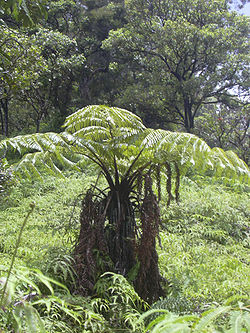- Cibotium
-
Cibotium 
Hāpuʻu ʻiʻi (Cibotium menziesii) Scientific classification Kingdom: Plantae Division: Pteridophyta Class: Pteridopsida Order: Cyatheales Family: Cibotiaceae
sensu Smith et al. (2006)Genus: Cibotium
Kaulfuss (1824)Species See text.
Cibotium (from the Greek kibootion, meaning chest or box) is a genus of eleven species of tropical tree fern—subject to much confusion and revision—distributed fairly narrowly in Hawaiʻi (four species, plus a hybrid, collectively known as hāpuʻu), Southeast Asia (five species), and the cloud forests of Central America and Mexico (two species). Some of the species currently listed in the literature seem to be synonyms or local-variant subspecies. Cibotium glaucum, from Hawaiʻi, is the most frequently encountered Cibotium species in the horticultural trade, together with its sibling species Cibotium chamissoi and the potentially huge Cibotium menziesii. The remaining Hawaiian Cibotium, C. nealiae, is a 1-metre (3.3 ft) dwarf variety, restricted to the island of Kauaʻi that is never seen in the horticultural trade. Precise identification of Cibotium species is difficult, although all have shiny and rather waxy fronds when viewed from above, with varying degrees of powdery-pale blush when seen from underneath. The natural habitat of Cibotium is among the dripping trees and stream gulleys of the rainforests on Hawaiʻi's windward volcanic slopes.
Pressure on Hawaiian Cibotium habitats comes from development encroaching on the forested areas, especially the more accessible lower lying areas which are commercially attractive for land clearance. A less obvious threat comes from an invasive introduced tree fern species: Cyathea cooperi (the most popular garden tree fern in the United States), which has escaped from the islands' suburban gardens and now out-competes the endemic flora. Wind-blown spores from this rapidly growing Australian import can migrate many miles into pristine Cibotium forests. This is a fairly recent phenomenon, but one which may eventually have grave consequences for the tree fern ecosystem in Hawaiʻi.
The other Cibotium species that often surface in botanical collections are Cibotium schiedei and Cibotium regale (Mexico), plus Cibotium barometz (Asia). The latter species is best known for its role in ancient medicine, and even today its hairs are a staple ingredient in ointments used in natural Chinese remedies. The medieval world was beguiled by stories that claimed C. barometz, the "Scythian lamb", was half-sheep and half vegetable.
There are no publicly accessible Cibotium collections growing outdoors in the United Kingdom - although they are sometimes glimpsed in Californian garden designs - but there are two outstanding glasshouse collections at the Royal Botanic Gardens, Kew, and at RBG Edinburgh in Scotland.
Species
- Cibotium arachnoideum
- Cibotium assamicum
- Cibotium barometz (L.) J.Sm. - Scythian Lamb (China, western Malay Peninsula)
- Cibotium chamissoi Kaulf. - Hawaiian tree fern, Hāpuʻu ʻiʻi[1]
- Cibotium cumingii Kunze, 1841 (Philippines, Taiwan)
- Cibotium glaucum (Sm.) Hook. & Arn. - Hawaiian tree fern, Hāpuʻu pulu[2]
- Cibotium menziesii Hook. & Arn., 1844 - Hawaiian tree fern, Hāpuʻu ʻiʻi
- Cibotium nealiae - Hawaiian tree fern, Hāpuʻu
- Cibotium regale - Royal cibotium
- Cibotium schiedei - Mexican tree fern
- Cibotium sumatranum
References
- ^ Little Jr., Elbert L.; Roger G. Skolmen (1989) (PDF). Hāpuʻu-ʻiʻi, Hawaiian treefern. United States Forest Service. http://www.ctahr.hawaii.edu/forestry/data/CommonTreesHI/CFT_Cibotium_chamissoi.pdf.
- ^ Little Jr., Elbert L.; Roger G. Skolmen (1989) (PDF). Hāpuʻu pulu, Hawaiian treefern. United States Forest Service. http://www.ctahr.hawaii.edu/forestry/data/CommonTreesHI/CFT_Cibotium_glaucum.pdf.
- Smith, A.R., K.M. Pryer, E. Schuettpelz, P. Korall, H. Schneider & P.G. Wolf 2006. A classification for extant ferns.PDF (420 KiB) Taxonomy 55(3): 705-731.
Categories:- Flora of Hawaii
- Cyatheales
- Medicinal plants
Wikimedia Foundation. 2010.
